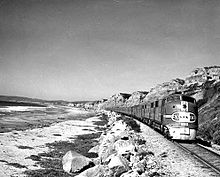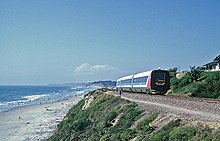Surf Line

The Surf Line is a railroad line that runs from San Diego north to Orange County along California's Pacific Coast. It was so named because much of the line is near the Pacific Ocean, within less than 100 feet (30 m) in some places. The tracks are now owned by the Southern California Regional Rail Authority and the North County Transit District, and hosts Metrolink's Orange County Line and Inland Empire–Orange County Line, the San Diego Coaster, and Amtrak Pacific Surfliner passenger trains. The BNSF Railway operates freight over the line using trackage rights.
History[]

Construction of the Surf Line between Los Angeles and San Diego began on October 12, 1880, with the organization of the California Southern Railroad Company. On January 2, 1882, the California Southern commenced passenger and freight service between National City and Fallbrook Junction, just north of Oceanside.[1] From Oceanside the line turned northeast for a winding route through the Temecula Canyon, and was finished on August 21, 1882.[2]
The line became part of the Atchison, Topeka and Santa Fe Railroad's transcontinental rail line in 1885 via an extension of the California Southern from Colton north over the Cajon Pass to Barstow. From 1886 to 1888, the Riverside, Santa Ana and Los Angeles Railway built a branch from Highgrove southwest via Riverside to Santa Ana and from Orange (just north of Santa Ana) northwest to Los Angeles. Also in 1888 the San Bernardino and San Diego Railway completed its line from Oceanside north to Santa Ana, completing what was originally called the Los Angeles–San Diego Short Line. The now-downgraded old route was destroyed by floods in 1891 and the new line, later named the Surf Line, was now the only line to San Diego from the north.
In 1910, the Fullerton and Richfield Railway built a short cutoff of the San Bernardino–Los Angeles route from Atwood west to Fullerton, giving the Surf Line its northern terminus of Fullerton.[citation needed]
For much of the 20th century, the Surf Line (officially, the Fourth District of the Los Angeles Division[3]) was to the Santa Fe what the New York City–Philadelphia corridor was to the Pennsylvania Railroad.[according to whom?] Daily traffic could reach a density of ten trains (each way) during the summer months. The route hosted AT&SF San Diegan passenger trains, renamed the Pacific Surfliner by Amtrak in 2000.[4] The Santa Fe installed centralized traffic control in 1943–1944 which increased capacity on the line.[5]
Santa Fe sold the line to local transportation authorities in 1992, with ownership split between the Southern California Regional Rail Authority in Orange County and the San Diego Northern Railway in San Diego County.[6]
Operations[]
| show Orange Subdivision |
|---|
| show San Diego Subdivision |
|---|
Commuter trains began operating in the 1990s, initially as an outgrowth of existing Amtrak services before assuming the identities of Metrolink and Coaster. Coaster runs within San Diego County, between San Diego and Oceanside, while Metrolink's services operate north of Oceanside. Amtrak's Pacific Surfliner travels throughout the corridor. The San Diego Trolley light rail shares the Surf Line's right of way in San Diego, running adjacent to the heavy rail tracks.





About two-thirds of the 60-mile (97 km) segment from the Orange County line to the Santa Fe Depot in downtown San Diego has been double-tracked. As one of the nation's busiest corridors, local transportation and planning agencies want to complete the entire section.[7] A 2.6-mile (4.2 km) section of double track between Elvira (SR 52) and Morena (Balboa Avenue) was completed in July 2020. The $192 million project, which began in August 2015, completed 14.6 miles (23.5 km) of double track from San Diego northward.[8]
Issues[]

The tracks are adjacent to coastal bluffs some 40 feet (12 m) above the beach for 1.7 miles (2.7 km) in Del Mar.[9] Persistent coastal erosion eats away at the bluff each year and the rate has accelerated due to sea level rise due to climate change. The bluff has had to be shored up to safely run current operations.[10] Steel beams were driven into the beach at the base of the bluff in September 2020 to stabilize the face of the bluff for 20 or 30 years.[11]
In August, the California Coastal Commission had emphasized the need to move the railroad tracks inland as they reviewed the emergency permits for the stabilization work. The San Diego Association of Governments(SANDAG) is conducting a $3 million study on relocating the rail line.[11] A tunnel under Del Mar, which would cost more than $3 billion, is being considered.[12]
The segment of the LOSSAN Corridor within San Diego County achieved full implementation of positive train control in December of 2018, for all passenger and freight trains operating on this segment.[13]
Historic station stops[]
This section does not cite any sources. (August 2021) |
These are not all the stations that currently operate. Many of these stations no longer exist (i.e. Linda Vista) and new ones have opened (i.e. Sorrento Valley). For a list of stations that currently operate, see the articles for Metrolink's Orange County Line and the Coaster.
- Santa Fe Los Angeles Division — Fourth District
- Los Angeles Union Passenger Terminal
- Santa Fe Springs
- Fullerton
- Anaheim
- Orange
- Santa Ana
- Irvine
- San Juan Capistrano
- San Clemente
- Oceanside
- Carlsbad
- Encinitas
- Del Mar
- Linda Vista
- Union Station (San Diego)
See also[]
- The Coast Line, continuing north from Los Angeles to San Francisco. It is owned by the SCRRA between Los Angeles and Moorpark, and Union Pacific from Moorpark onwards.
- History of rail transportation in California
- North Coast Corridor
Notes[]
- ^ Duke 1995, p. 50
- ^ Duke 1995, pp. 53–54
- ^ Richardson 2005, p. 38
- ^ Gabbard, Dana (September 24, 2012). "History of the Surfliner, LOSSAN and a Look at Pending Legislation". StreetsBlog LA. OpenPlans. Retrieved 2015-03-27.
- ^ Jordan 2004, p. 69
- ^ Stein, Mark A.; Perlman, Jeffrey A. (June 19, 1992). "Santa Fe, Transit Officials Reach Rail Deal : Commuting: The $500-million agreement for 336 miles of track means expanded O.C. passenger service". Los Angeles Times. Archived from the original on December 21, 2014.
- ^ Diehl, Phil (2019-08-19). "Coastal Commission frowns on trenching idea for rail tracks atop oceanfront bluffs". Los Angeles Times. Retrieved 2019-08-19.
- ^ "SANDAG Completes Major Railway Project Connecting more than 14 Miles of Continuous Double Tracking". Claremont Times. July 15, 2020.
- ^ "Del Mar Bluffs Stabilization Project". SANDAG : San Diego's Regional Planning Agency. Retrieved 2020-10-25.
- ^ Diehl, Phil (2020-10-25). "California opposes district's bid to control Del Mar bluffs, erect chain-link fence". Los Angeles Times. Retrieved 2020-10-25.
- ^ Jump up to: a b Little, Joe (September 22, 2020). "Steel Beams Installed to Reinforce Del Mar Beach Bluffs". NBC 7 San Diego. Retrieved 2020-09-24.
- ^ Diehl, Phil (2020-08-16). "State Coastal Commission says Del Mar train tracks need to move inland". San Diego Union-Tribune. Retrieved 2020-08-16.
- ^ "Positive Train Control (PTC) Fact Sheet" (PDF). NCTD. 2 July 2019.
References[]
- Duke, Donald (1995). Santa Fe...The Railroad Gateway to the American West. 1. San Marino, CA: Golden West Books. ISBN 0-8709-5110-6. OCLC 32745686.
- Jordan, Keith (1996). "The Surf Line 1940–1950". The Warbonnet. 2 (2): 4–24.
- Jordan, Keith (1996). "The Surf Line Part II: 1950–1965". The Warbonnet. 2 (4): 11–24.
- Jordan, Keith (August 2004). "Santa Fe Surf Line, 1940" (PDF). Trains. 64 (8): 64–69. ISSN 0041-0934.
- Richardson, Don (June 2005). "The secret borax train" (PDF). Classic Trains. 6 (2): 36–39.
External links[]
- Amtrak
- Rail lines in California
- Public transportation in Southern California
- Atchison, Topeka and Santa Fe Railway
- Atchison, Topeka and Santa Fe Railway lines
- Amtrak lines